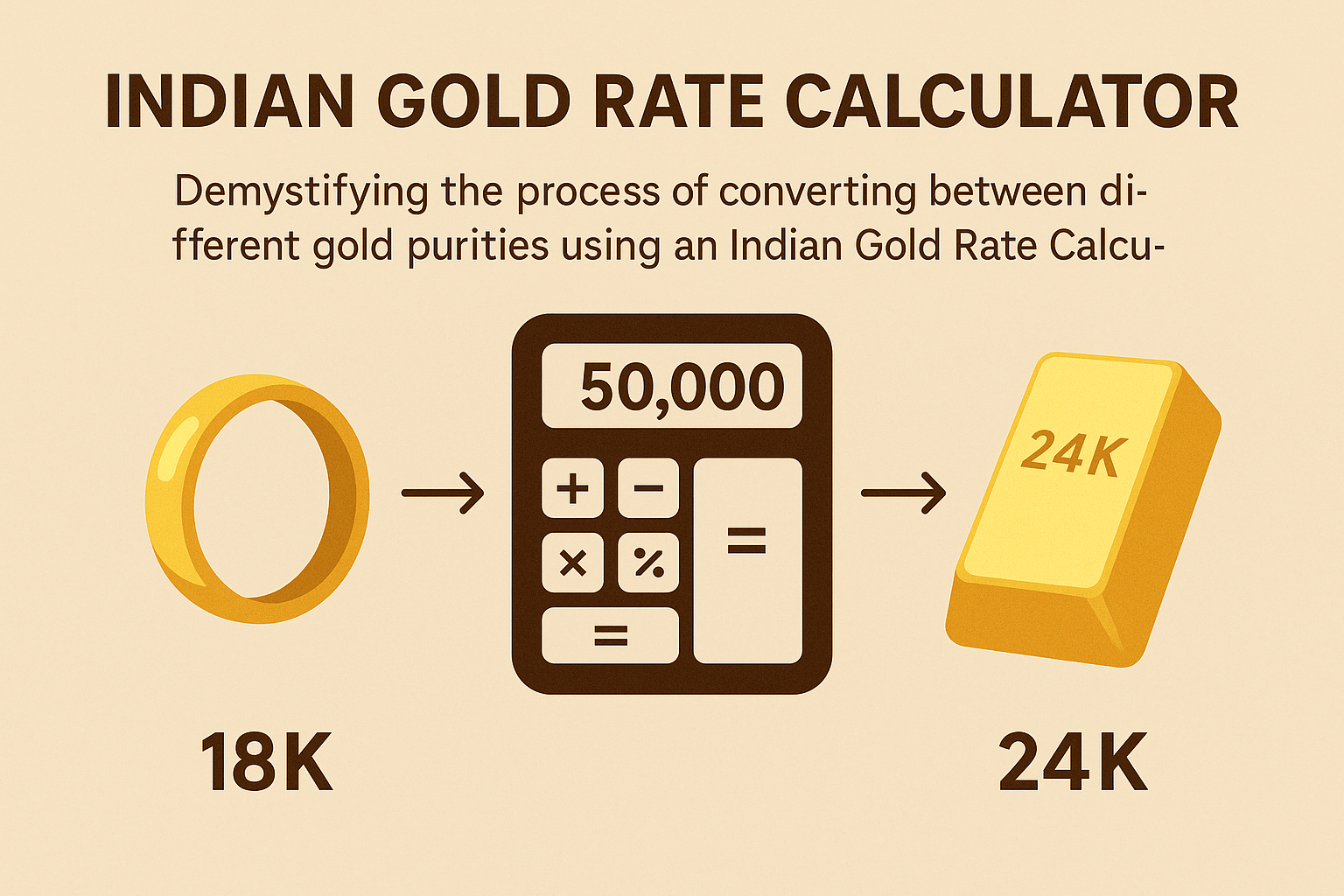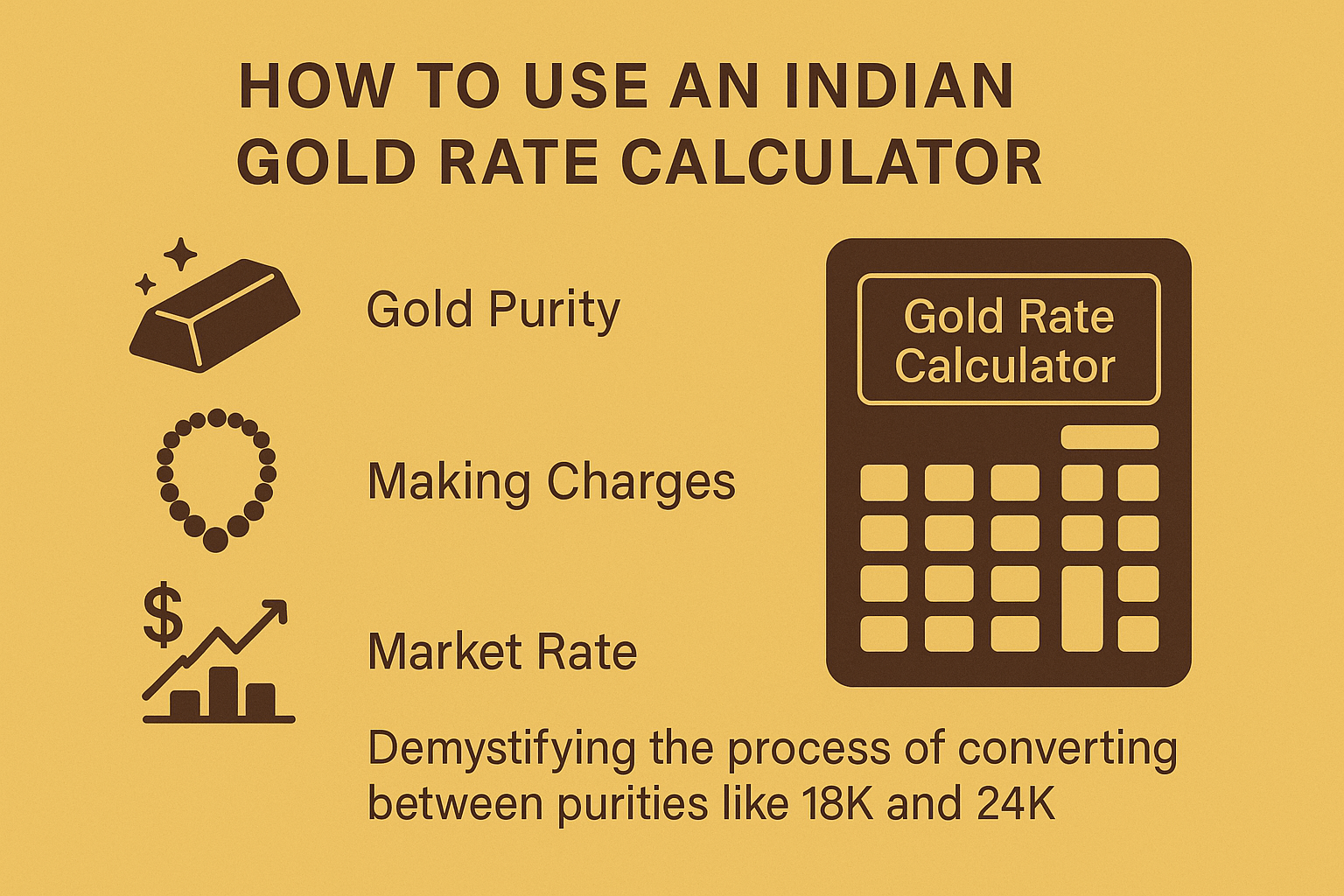Navigating the glittering world of gold in India can be as complex as (Indian Gold Rate Calculator) it is fascinating. Whether you’re investing in bars, buying a wedding necklace, or exchanging an old piece, the price you see isn’t just for weight. It’s a interplay of purity, making charges, and daily market rates. This is where understanding how to use an Indian Gold Rate Calculator becomes your superpower, especially when converting between different purities like 18K and 24K. Let’s demystify this process.
Why Purity Matters: The Karat System Explained
Before we dive into calculations, it’s crucial to understand what we’re measuring. The ‘Karat’ (K) denotes the purity of gold in an alloy. Pure gold is 24 karats, but it’s too soft for everyday jewellery. To make it durable, it’s mixed with other metals like copper, silver, or zinc.
-
24K Gold: This is 99.9% pure gold. It has a rich, deep yellow color but is malleable. It’s primarily used for investment (bars, coins) and not for typical jewellery.
-
22K Gold: The sweet spot for most Indian jewellery. It is 91.6% pure gold (22/24ths) and is strong enough for daily wear. This is the standard for traditional pieces like mangalsutras, bangles, and chains.
-
18K Gold: Contains 75% pure gold (18/24ths). It’s harder and is often used in contemporary, diamond-studded, or intricate jewellery designs. Its color is slightly less yellow than 22K or 24K gold.
Understanding this purity scale is the first step to making informed decisions and using a gold rate calculator effectively.

The Heart of the Matter: How an Indian Gold Rate Calculator Works for Purity Conversion
An Indian Gold Rate Calculator isn’t a single magical device but a simple mathematical formula. Its primary function is to find the value of the pure gold content in your jewellery based on the day’s market price.
The core formula is straightforward:
Value of Your Gold Item = (Weight in Grams) x (Purity in Karats / 24) x (Daily 24K Gold Rate per Gram)
Let’s break this down with a real-world example.
Example Scenario:
Imagine today’s 24K gold rate in Mumbai is ₹6,000 per gram. You have an old 18K gold bracelet that weighs 10 grams. You want to know its melt value, or how much it would be worth if you were to sell it based purely on its gold content.
-
Determine the Purity Factor: For 18K gold, the purity factor is 18/24 = 0.75. This means 75% of the weight is pure gold.
-
Apply the Formula:
-
Weight = 10 grams
-
Purity Factor = 0.75
-
24K Rate = ₹6,000/gram
-
Value = 10 gm x 0.75 x ₹6,000/gm = ₹45,000
-
So, the pure gold content of your 18K bracelet is worth ₹45,000.
Converting 18K to 24K Value
The calculation above already does this! By multiplying the weight by the purity factor (18/24), you have effectively found out how much pure 24K gold your 18K item contains. In this case, your 10 grams of 18K gold is equivalent to 7.5 grams of 24K gold (10 gm x 0.75).
Beyond Purity: The Real-World Cost of Buying Gold
When you buy jewellery, the calculation isn’t this simple. You must account for additional costs that are layered on top of the pure gold value. A savvy user of an Indian Gold Rate Calculator always factors these in:
-
Making Charges (Karigar Charge): This is the cost of craftsmanship. It can be a flat fee, a percentage of the gold value (often 8% to 25%), or per gram. Intricate designs have higher making charges.
-
GST (Goods and Services Tax): The Indian government levies a 3% GST on gold jewellery (2.5% on gold + 1.5% making charge, though it’s often applied as a total of 3% on the final value).
-
Hallmarking Charges: A small fee for certifying the purity and authenticity of the jewellery.
Buying Calculation Example:
Let’s say you are buying a new 22K gold chain weighing 12 grams. The daily 24K rate is ₹6,000/gram.
-
Purity Factor for 22K = 22/24 = 0.9167
-
Gold Value = 12 gm x 0.9167 x ₹6,000 = ₹66,002.4
-
Making Charges (@15%) = 15% of ₹66,002.4 = ₹9,900.36
-
Subtotal = ₹66,002.4 + ₹9,900.36 = ₹75,902.76
-
GST @3% = 3% of ₹75,902.76 = ₹2,277.08
-
Final Price = ₹75,902.76 + ₹2,277.08 = ₹78,179.84
This final price is what you will pay at the jeweller, a significant difference from the simple melt value.

How to Use an Online Gold Rate Calculator
Most financial websites (like BankBazaar) or jeweller websites (like Tanishq) offer free online calculators. Here’s how to use them:
-
Select your city (as gold rates vary by city due to local taxes).
-
Input the weight of your gold in grams.
-
Select the purity (e.g., 18K, 22K, 24K).
-
Choose your purpose (Buying / Selling). For selling, it will show the approximate value of the gold content. For buying, it may ask for making charge % and GST to give you an estimate.
Pro Tips and Insights for the Indian Consumer
-
Always Ask for a Hallmark: The Bureau of Indian Standards (BIS) hallmark is your guarantee of purity. It includes the BIS logo, purity in karats (e.g., 22K916), and the jeweller’s identification mark.
-
Negotiate Making Charges: Unlike the gold price, which is fixed by the market, making charges are negotiable. Don’t hesitate to shop around and compare.
-
Understand the Exchange Policy: Many jewellers offer exchange schemes. When exchanging old jewellery for new, they will typically calculate the value of your old gold at its pure gold content weight and then deduct making charges and wastage from the new piece. Use the calculator to know the true value of your old gold before you walk into the store.
Conclusion
An Indian Gold Rate Calculator is more than just a tool; it’s an essential component of financial literacy for anyone engaging with the gold market. By understanding the simple math behind converting 18K to 24K values and accounting for making charges and taxes, you transform from a passive buyer into an informed consumer. You empower yourself to ask the right questions, negotiate better, and ensure that your investment shines as brightly as the gold itself. The next time you consider a gold purchase, let this knowledge be your guide.
Frequently Asked Questions (FAQs)
1. Is 18K gold better than 22K gold?
It depends on the purpose. For purity and investment value, 22K and 24K are better. For durable, intricate, and modern jewellery that sees daily wear, 18K is an excellent choice due to its strength.
2. Why do gold rates differ from city to city in India?
The primary reason is the variation in state-level taxes and VAT (Value Added Tax), which are applied on top of the national base price and GST. Transportation costs and local demand can also cause minor fluctuations.
3. How often do gold rates change?
Gold rates in India change multiple times throughout the day. They are influenced by the international spot price of gold (in USD), the USD/INR exchange rate, and local market demand and supply.
4. Can I get the full 24K value for my 22K jewellery?
No. When selling, you will be paid for the actual pure gold content. For 22K jewellery, you will get paid for 91.6% of its weight at the day’s 24K gold rate. Jewellers may also deduct a small refining fee or buy-back charge.
5. Where can I find the most accurate daily gold rate?
The India Bullion and Jewellers Association (IBJA) website is a reliable source for daily opening rates. Major banks and reputable jeweller websites also provide accurate, up-to-date rates.
Disclaimer: This article is for educational and informational purposes only. The gold rates used are examples and may not reflect the current market price. The calculations provided are a general guide; actual prices at jewellers may vary due to a number of factors. We do not guarantee the accuracy of this information. If you have any concerns about the content published here, please visit our DMCA page to understand our content removal guide and process for verifying ownership or addressing other issues.
